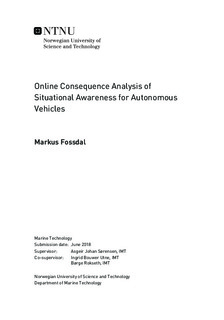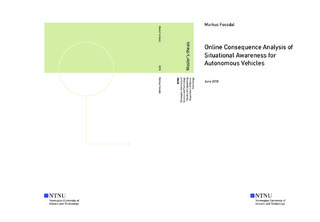| dc.description.abstract | The maritime industry is undergoing substantial changes with regards to autonomy, and lately important steps has been done in realizing highly autonomous vessels for industry use. This master s thesis presents a framework for an online consequence analysis (OCA) as an approach for increased situation awareness (SA), for marine vessels in transit. It cov- ers important steps towards this, in form of an overview of how different industries have defined autonomy, and how situation awareness currently is achieved for autonomous sys- tems. The proposed framework is validated through simulation, and lastly a general discus- sion is presented, including positive outcome and challenges with the framework.
A review of how different industries have defined taxonomies for level of autonomy (LoA) is conducted, along with a review on how situation awareness is achieved for a marine vessel. Based on this, a comparison between the different taxonomies and how they fare with each other is provided, together with a visualization of how different sensors are used in order to achieve the first step of situation awareness, perception of the surrounding environment. The second and third step of SA are comprehension and projection, and this is where the OCA contributes.
The proposed framework is able to simulate the vessel s dynamics in different failure modes, when initialized at the vessel s current state and with the prevailing weather condi- tions. Results from the OCA simulations are evaluated with respect to the vessel s distance to obstacles, and a consequence level for each failure mode is calculated. Based on the consequence levels, a quantitative measure of the total risk of collision is presented online, which builds a foundation for further decision-making.
Furthermore, a simulation model was built in order to validate the functionality of the proposed OCA. A case study presents a set of scenarios simulated for validation, consisting of straight line transit, simple maneuvering between static obstacles and passage through a narrow channel. The results from the simulations showed promising behavior of the OCA. It was able to capture transient effects and the overall increase in risk when maneuvering in confined waters. The simulation model is flexible, as it allows for testing several failure modes and capture potential severe consequences. Initialization frequency of the OCA was important as it affected resolution of the risk indicator. A result of increasing the frequency was an earlier discovery of potential risk.
The applicability and limitations of the framework are discussed, and proposals for further work are suggested, together with a brief discussion regarding the framework s compli- ance with COLREGs. Based on an assessment of the research question in hindsight of the development process, it is concluded that the framework allows for increased situa- tion awareness and that it shares capabilities of those defined as a LoA-3 management by exception autonomy level.
It is further recommended to expand the framework by implementation of moving obsta- cles. This will enhance the framework s capabilities to comprehend perceived information, thus making better calculations of consequence levels and associated risk. | |

